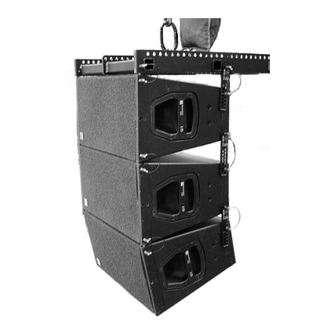d&b audiotechnik Q Series Manuale d'attrezzatura - Pagina 15
Sfoglia online o scarica il pdf Manuale d'attrezzatura per Cremagliere e cavalletti d&b audiotechnik Q Series. d&b audiotechnik Q Series 18. Flying frame, flying adapter

WARNING!
bft
knots
km/h
0
0-1
0-1
1
1-3
1-5
2
4-6
6-11
3
7-10
12-19
4
11-16
20-28
5
17-21
29-38
6
22-27
39-49
7
28-33
50-61
8
34-40
62-74
9
41-47
75-88
10
48-55
89-102
11
56-63
102-117
12
> 64
> 117,0
Tab. 1: Wind force and its effects on land
WARNING!
Fig. 33: Securing the
array using a second Q
Flying frame
WARNING!
Q-Series Rigging manual
6. Wind loads
When loudspeaker arrays are flown in an open air
environment, possible wind effects should be taken into
account. Wind load will produce additional dynamic
forces to the rigging components and the suspension,
which may lead to a dangerous situation.
Generally flying loudspeakers overhead at wind forces
higher than 6 bft is not recommended.
When planning an open air event it is essential to get
current weather and wind information.
The following wind speed scale according to Beaufort
gives an impression of the effects of the different wind
forces (bft).
mph
Description
0-1
Calm
1-3
Light Air
4-7
Light breeze
8-12
Gentle breeze
13-18
Moderate breeze
19-24
Fresh breeze
25-31
Strong breeze
32-38
Near gale
39-46
Gale
47-54
Severe gale
55-63
Storm
64-72
Violent storm
> 72
Hurricane
If according to the forecast wind forces higher than 5 bft are
possible the following actions have to be taken:
‐ The actual on site wind speed has to be monitored
permanently. Be aware that wind speed typically
increases with height above ground.
‐ Suspension and securing points of the array should be
designed to accomodate double the static load in order to
withstand any additional dynamic forces.
‐ Arrays with more than three cabinets have to be secured
using a second Q Flying frame at the bottom of the
column. Wires or ropes have to be connected to the Q
Flying frame and not to the cabinets rigging sockets (Fig.
33).
If the wind force exceeds 8 bft there is a risk of mechanical
damage to the components which may lead to a dangerous
situation for persons in the vicinity of the flown array.
Stop the event and make sure that no one is left within the
vicinity of the array.
Lower down and secure the array.
(1.2EN)
Effects on land
Smoke rises vertically.
Direction of wind shown by smoke drift, but not by wind vanes.
Wind felt on face; leaves rustle; ordinary vanes moved by wind.
Leaves and small twigs in constant motion; wind extends light flag.
Raises dust and loose paper; small branches are moved.
Small trees in leaf begin to sway; crested wavelets form on inland
waters.
Large branches in motion; whistling heard in telegraph wires;
umbrellas used with difficulty.
Whole trees in motion; inconvenience felt when walking against the
wind.
Breaks twigs off trees; generally impedes progress.
Slight structural damage occurs (chimney-pots and slates removed).
Trees uprooted; considerable structural damage occurs.
Accompanied by wide-spread damage.
Heaviest damage and destruction.
Page 15 of 20
